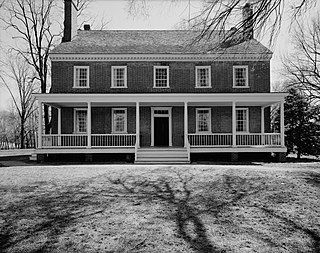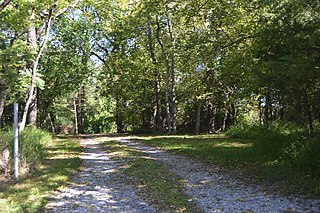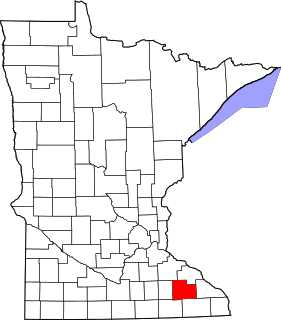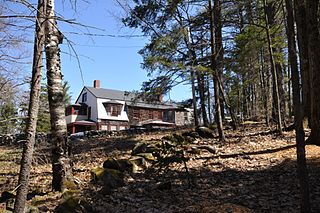
Historic Locust Grove is a 55-acre 18th-century farm site and National Historic Landmark situated in eastern Jefferson County, Kentucky. The site is owned by the Louisville Metro government, and operated as a historic interpretive site by Historic Locust Grove, Inc.

Charles A. Lindbergh State Park is a 569-acre (2.3 km2) Minnesota state park on the outskirts of Little Falls. The park was once the farm of Congressman Charles August Lindbergh and his son Charles Lindbergh, the famous aviator. Their restored 1906 house and two other farm buildings are within the park boundaries. The house, a National Historic Landmark, and an adjacent museum are operated by the Minnesota Historical Society, known as the Charles Lindbergh House and Museum. Three buildings and three structures built by the Works Progress Administration in the 1930s were named to the National Register of Historic Places. These buildings include a picnic shelter and a water tower, built in the Rustic Style from local stone and logs, and have remained relatively unchanged since construction. Although the property includes shoreline on the Mississippi River, the Lindbergh family requested that the park not include intensive use areas for swimming or camping, so development was kept to a minimum.

Lower Brandon Plantation is located on the south shore of the James River in present-day Prince George County, Virginia.

The Middletown Alms House is a historic building at 53 Warwick Street in Middletown, Connecticut, constructed in 1813-1814. It was originally used as a poorhouse and is the oldest surviving building built for housing the poor in Connecticut, as well as one of the oldest such in the United States. One of the largest structures of the Federal period in Middletown, it was listed on the National Register of Historic Places in 1982.

The Crailo State Historic Site is a historic, fortified brick manor house in Rensselaer, New York which was built in 1707. The word Crailo is derived from kraaien bos and refers to Kiliaen van Rensselaer's estate in Huizen, Holland, which is also named "Crailo". Fort Crailo is listed on the National Register of Historic Places.

The Stiegel-Coleman House, also known as Elizabeth Farms, is a historic mansion house at 2121 Furnace Hills Pike, just north of Brickerville, Pennsylvania. Built in 1757 and substantially enlarged in 1780, it was the home of two of colonial Pennsylvania's early iron and glass makers, William Stiegel and Robert Coleman. The furnace they operated, whose archaeological remains were rediscovered in 2004, was one of the most successful in the Thirteen Colonies, and provided war materials for Continental Army. Their house was declared a National Historic Landmark in 1966. It has remained in the hands of Coleman descendants, mostly as a private residence.

Cedar Lawn, also known as Berry Hill and Poplar Hill, is one of several houses built near Charles Town, West Virginia for members of the Washington family. Cedar Lawn was built in 1825 for John Thornton Augustine Washington, George Washington's grand-nephew. The property was originally part of the Harewood estate belonging to Samuel Washington. The property that eventually became Cedar Lawn was left to Samuel's son, Thornton Washington, who built "Berry Hill", named for his wife's family. Berry Hill was destroyed by fire, and John Thornton Augustine built Cedar Lawn when he inherited.

Harewood is one of several houses in the vicinity of Charles Town, West Virginia built for members of the Washington family.

Altona, near Charles Town, West Virginia, is a historic farm with an extensive set of subsidiary buildings. The original Federal style plantation house was built in 1793 by Revolutionary War officer Abraham Davenport on land purchased from Charles Washington. The house was expanded by Abraham's son, Colonel Braxton Davenport. During the Civil War the farm was a favored encampment. Generals Philip Sheridan and Ulysses S. Grant both used the house as a headquarters and meeting place.
Woodlawn, also known as Wiltshire House or Wiltshire Farm, was built circa 1820, one of four homes within a two-mile radius by James Hurst, a significant landowner in Jefferson County. Hurst built the first three houses for his children on his "LaGrange" plantation around 1811, including "Snow Hill' (now known as the Jefferson County Alms House and the Coyle House. Woodlawn was built for the adopted daughter of Samuel Davenport, whose married name was Camilla Wiltshire. All of these homes used salt-glazed brick, as did Elmwood and the Tate-Fairfax-Muse House.

The Strider Farm was intimately involved in events concerning the American Civil War near Harpers Ferry, West Virginia. Located on a small hill just south of the Baltimore and Ohio Railroad line from Baltimore and Washington, D.C. to Martinsburg, West Virginia, the Strider farm was a strategic location for the control of this vital link.
The Jacks–Manning Farm, also known as the Vinton Farm was built around 1840 for Robert Jacks near Charles Town, West Virginia, in the Greek Revival style. Jacks had married Julia Davenport, a member of a prominent Jefferson County family. Their daughter, Rebecca Jacks, married Thomas J. Manning, and the property has remained in the hands of descendants of the Manning family.

Gap View Farm, near Charles Town, West Virginia, is a historic farm complex built in 1774. The farm was placed on the National Register of Historic Places on January 9, 1997.

The Taunton Alms House is a historic alms house at 350 Norton Avenue in Taunton, Massachusetts. The present facility was built in 1876 as a poorhouse, and was enlarged in the 20th century after its conversion to a nursing home. The building is architecturally a fine example of institutional Italianate architecture, and is an important reminder of progressive social services provided in the late 19th century. The building was added to National Register of Historic Places in 1984.

This is a list of the National Register of Historic Places listings in Olmsted County, Minnesota. It is intended to be a complete list of the properties and districts on the National Register of Historic Places in Olmsted County, Minnesota, United States. The locations of National Register properties and districts for which the latitude and longitude coordinates are included below, may be seen in an online map.

This is a list of the National Register of Historic Places listings in Houston County, Minnesota. It is intended to be a complete list of the properties and districts on the National Register of Historic Places in Houston County, Minnesota, United States. The locations of National Register properties and districts for which the latitude and longitude coordinates are included below, may be seen in an online map.

The Mary Anne Wales House, also known as The Briar-Patch, is a historic house on Snow Hill Road in Dublin, New Hampshire. Built in 1886, it is a well-preserved local example of the Shingle style, and an early residence of the town's late 19th-century summer resort colony. The house was listed on the National Register of Historic Places in 1983.
In the United States, a gentleman farmer is a landowner who has a farm as part of his estate and who farms mainly for pleasure rather than for profit or sustenance.
Bedford County Alms House, also known as Bedford County Home, is a historic almshouse and national historic district located at Bedford Township, Bedford County, Pennsylvania. The district includes six contributing buildings. They are the Alms House (1872-1873), infirmary building (1899), laundry (1900), and a storage shed and two barns built between the early 1900s and about 1950. The Alms House is a four-story, brick building, 13-bays wide and 3-bays deep. It has a hipped roof and features a central tower with porches. The facility closed in 1978.

Maplewood, also known as the David C. Voorhees House or the John A. Voorhees House, was a historic building overlooking Burnt Hill Road at Rock Brook in Montgomery Township, Somerset County, New Jersey. It was added to the National Register of Historic Places on August 24, 2000. It was destroyed by fire on November 19, 2011.


















